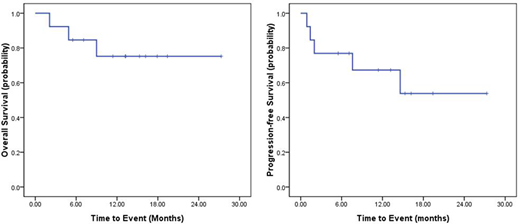Objective: Outcome of patients with relapsed/refractory (r/r) diffuse large B-cell lymphoma (DLBCL) remains poor, highlighting the need for novel treatment regimens. Lenalidomide is an immunomodulatory drug that could reverse rituximab refractoriness in lymphoma patients. This study aimed to explore the efficacy and safety of lenalidomide, rituximab combined with second-line chemotherapy (R2-chemo) in patients with r/r DLBCL.
Methods: In this study, r/r DLBCL patients received R2-chemo as second-line salvage therapy. The treatment plan was as follows: lenalidomide 10mg/day, day 1-14; rituximab 375mg/m2, day 1; chemo-regimen in combination with R2 as per Investigator's discretion. The overall response rate (ORR), complete remission rate (CR rate), duration of remission (DOR), disease-free survival (PFS) and overall survival (OS) were evaluated.
Results: As of Aug 1, 2020, 15 patients with r/r DLBCL were enrolled in this study with median age 65 years (range, 49 to 74 years), and 60% female. 20% (3/15) was transformed DLBCL, 33.3% (5/15) was relapse and 46.7% (7/15) had refractory disease. All received at least 1 prior line of immune-chemotherapy including rituximab, and 1 case was recurrence after autologous hematopoietic stem cell transplantation. 6.7% (1/15) had double-hit lymphoma, 66.7% (10/15) had MYC or BCL-2 high expression by IHC, of whom 26.7% (4/15) had co-expression of the MYC and BCL2. Cell of origin features using the Hans algorithm: 26.7% (4/15) were GCB, and 73.3% (11/15) were non-GCB. The chemo-regimens in combination with R2 were as follows: 5 cases of GEMOX or GCD, 7 cases of DICE or ICE, 2 cases of DHAP, 1 case of CHOPE regimen. As of the cutoff date, 13 cases were evaluable for efficacy. The ORR (CR+PR) was 61.5%, with 53.8% achieving a CR, and the median DOR was 9.7m (range, 2.9 to 23.7m). With a median time to follow-up of 15.3m (95%CI, 12.2 to 18.4m), median PFS and OS had not yet reached. The estimated 2-year PFS and OS rates were 53.8% and 75.2%, respectively. The most common treatment-related adverse event was hematological toxicity, and no treatment-related deaths occurred.
Conclusion: The R2 combined with second-line salvage chemotherapy regimen has a significant efficacy in the treatment of patients with r/r DLBCL, and can be well- tolerated with no significant additive toxicities. The efficacy and safety of this regimen and the choice of chemo-regimen as an optimal combination partner for R2 need to be further verified by prospective clinical studies with a larger sample size.
No relevant conflicts of interest to declare.
Author notes
Asterisk with author names denotes non-ASH members.


This feature is available to Subscribers Only
Sign In or Create an Account Close Modal